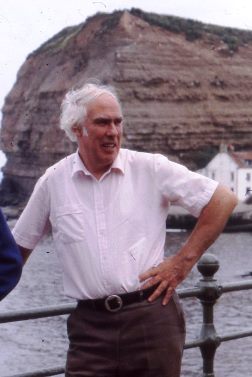
Leading palaeontologist, geologist and geological writer of his generation
Tony Hallam passed away after a short illness on 23 October 2017. Tony was one of the leading Earth science academics of the late 20th Century, making major contributions to an amazing number of fields, including palaeoecology, evolution, mass extinctions, sea-level change, palaeoclimatology, palaeobiogeography and history of science. He wrote 120 papers, nearly all single-author, and 10 books that all became classics, translated into numerous languages. He was awarded the Lyell Medal by the Society in 1990 and the Lapworth Medal by the Palaeontological Association in 2007.
Picture: Tony Hallam on fieldwork in Staithes, 1988.
Arkell
He studied at Cambridge University, where he graduated with a double first, and stayed to do his thesis under the supervision of that other great Jurassic worker, W J Arkell. Tony was the first to appreciate that detailed palaeoenvironmental stories could be had from the British Jurassic. In so doing, he initiated studies that provide the foundation for entire research fields today. His 1961 paper on the role of sea-level, anoxia and mass extinction in the Early Jurassic (Toarcian) was the first to identify this common motif in the geological record and contains ideas that were literally decades ahead of their time.
After Cambridge, Tony moved to Edinburgh University where he continued his Jurassic investigations, notably on sea-level change and the cyclostratigraphic record of the Blue Lias. Again these were pioneering contributions, the sequence stratigraphic revolution was more than a decade away. In 1967 Tony moved again, this time to Oxford University, and began a productive 10 years of research marked by contributions to the role of biogeography in understanding continental drift, and the publication of several seminal books. These include A Revolution in Earth Sciences (1973), the first synthesis of the plate tectonic revolution.
Luminaries
He also grew a highly successful team of research students, the initial intake including such luminaries as Bruce Sellwood, Geoff Townson, Franz Fürsich and Tim Palmer. Forty years later, looking back on these achievements, when nearly all academics today pursue ultra-specialised interests, Tony’s broad-ranging output looks like the efforts of an entire department. This is particularly so, if the prolific publications of his research students are included. Unlike the practice of today, Tony never felt the need to append his name to the efforts of his postgrads.
In 1977 Tony made his final move, taking up the post of Lapworth Professor at the University of Birmingham. There was no let-up in his productivity and he continued to publish numerous classic books that are masterpieces of scientific prose. His writing style was accessible, lively and concise. Tony always said he would have been a journalist if not an academic and there is no doubt he would have made a good one.
Tibetan
Tony retired in 1999 but continued his research for many years afterwards. At the age of 68 he could still be found on Tibetan mountainsides at 16,000 feet elevation, happily collecting Jurassic fossils. His final book, Mass extinctions and lesser calamities, published in 2006 is a typical Hallam tour de force: readable, ultra-concise and one of the best introductions to the field available.
By Paul Wignall